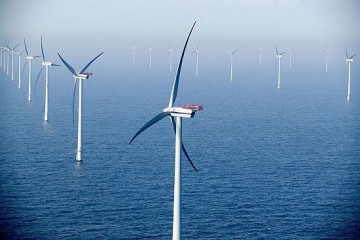RI Is Missing Its Greenhouse Gas Emission Reduction Goals - Mixed Results at Brown & RI Hospital
Saturday, April 02, 2022
Rhode Island has a goal to reduce greenhouse gas emissions (GHG) by 10% mandated by the Act on Climate -- but data released on Friday by the Department of Environmental Management (DEM) shows that the state is in fact increasing GHG — not reducing.
GHG in Rhode Island grew by 8.18% between 2017 and 2018, according to an analysis of the state’s 2018 GHG inventory conducted by DEM air quality specialists. The increase has driven the state’s emissions by 1.8% over the 1990 baseline year, well short of the 10% emissions reduction.
“There is no question that the data we are releasing today is a call to action for Rhode Island to do better, to fight climate change,” said RIDEM Acting Director Terry Gray. “The governor’s budget proposes more than $150 million in investments to do just that, following through on the urgency conveyed in the Act on Climate passed one year ago. The Executive Climate Change Coordinating Council (EC4) will be continuing important conversations with Rhode Islanders across the state on how to craft effective and equitable solutions to lower our emissions and the agencies in the EC4 will be implementing actions to make those reductions happen.”
GET THE LATEST BREAKING NEWS HERE -- SIGN UP FOR GOLOCAL FREE DAILY EBLASTIn absolute terms, the state produced 11.74 million metric tons of carbon dioxide (MMTCO2e) in 2017 and 12.70 MMTCO2e in 2018, resulting in an 8.18% change.
Gray said in a press briefing that he has not ruled out that the state can reverse course to achieve some of the targets. His agency will be analyzing the data from the pandemic years — 2020 and 2021.
From 2017 to 2018, GHG emissions increased in most major sectors: transportation, electricity consumption, residential heating, industry, commercial heating, and waste.
Some Major Producers Saw Decreases, But Continue to Be Major Emitters
According to data published by the U.S. EPA, the facilities that are major producers include power plants, Brown University, Rhode Island Hospital and Toray Plastics.
While some of the producers have decreased their production in recent years, the percentage decline in some cases has been minimal. In 2011, Brown University produced Total Facility Emissions in metric tons CO2 equivalent 28,810 — that number was reduced to 24,573 in 2020 -- a 14.7% decrease.
Rhode Island Hospital saw a significant increase -- in 2011 it produced 49,269 to 53,658 in 2020 -- an 8.9% increase.
In the longer 1990 to 2018 timeframe, however, only the electricity consumption and industrial sectors generated increases. RIDEM said neighboring states also have experienced increases in GHG emissions since 2017, with Connecticut reporting a 2.7% increase in its 2018 inventory and Massachusetts reporting a 0.68% increase in its 2018 inventory.
Legislation has been introduced calling for up to 600 MW of additional offshore wind, which has the potential to meet 30% of Rhode Island’s estimated 2030 electricity demand. The administration also is launching a rebate program to help Rhode Islanders switch to electric vehicles and has proposed a $37 million investment of federal funding to support the adoption of energy-efficient electric heat pumps.
Governor Dan McKee’s FY2023 budget and ARPA spending plan proposes more than $150 million to fund a series of proposals.
That proposal includes $60 million to improve infrastructure at the Port of Davisville to help expand the development of offshore wind projects, $35 million toward improving the South Quay Marine Terminal in East Providence also to support the offshore wind industry, $37 million toward the creation of an Electric Heat Pump Incentive Program to be run by OER, and $23 million in federal and state spending to expand RI’s network of electric vehicle charging stations through a joint incentive program managed by OER and the RI Department of Transportation.
The Governor also has proposed $6 million in funding for the EC4, which is the first time funding has been directed to the Council for critical work on climate change. The proposals will have no impact on state general revenues.
Related Articles
- Majority of Rhode Islanders Won’t Make Changes to Lower Greenhouse Gases
- EDITORIAL: Elorza Gives Tax Break to One Greenhouse Gas Producer But Blocks Another
- Magaziner Reaches Agreement with Archer Daniels Midland on Greenhouse Gas Emissions
- Horowitz: Progress On Climate Change is Possible Despite Trump
- Horowitz: National Climate Change Report Highlights Need for Action
- RI Joins 8 Other States to Announce Further Efforts to Fight Climate Change
- Civic Alliance for a Cooler RI Releases Assessment of Climate Change Act
- Horowitz: More Americans Becoming Concerned About Climate Change
- Stycos’ $5 Million Climate Change Bond Approved By Cranston City Council
- Rob Horowitz: COVID-19 and Climate Change
- RI DEM Awards $4.3 Million to Help RI Communities Confront Effects of Climate Change
- Horowitz: Americans Want More Action on Climate Change
- Rickman’s Big View - Climate Change Crisis in RI
- Climate Change - 21 Who Made a Difference in 2021






